Deck 5: Methods in Protein Biochemistry
Question
Question
Question
Question
Question
Question
Question
Question
Question
Question
Question
Question
Question
Question
Question
Question
Question
Question
Question
Question
Question
Question
Question
Question
Question
Question
Question
Question
Question
Question
Question
Question
Question
Question
Question
Question
Question
Question
Question
Question
Question
Question
Question
Question
Question
Question
Question
Question
Question
Question
Question
Question
Question
Question
Question
Question
Question
Question
Question
Question
Question
Question
Question
Question
Question
Question
Question
Question
Question
Question
Question
Question
Question
Question
Question
Question
Question
Question
Question
Question

Unlock Deck
Sign up to unlock the cards in this deck!
Unlock Deck
Unlock Deck
1/100
Play
Full screen (f)
Deck 5: Methods in Protein Biochemistry
1
The following peptides are separated using an anion exchange resin in ion-exchange chromatography. Which peptide is eluted first? 
A) A
B) B
C) C
D) D

A) A
B) B
C) C
D) D
D
2
Which peptide would migrate the slowest in an SDS-PAGE gel? 
A) A
B) B
C) C
D) D

A) A
B) B
C) C
D) D
C
3
Which percentage of polyacrylamide would give the best separation for large proteins?
A) 5%
B) 7.5%
C) 10%
D) 20%
A) 5%
B) 7.5%
C) 10%
D) 20%
5%
4
Why is the process of purifying proteins from cells considered challenging?
A) Proteins are insoluble.
B) The process is expensive and time consuming.
C) There is no way to determine the structure of the protein.
D) There are 10,000 to 100,000 proteins in one sample.
A) Proteins are insoluble.
B) The process is expensive and time consuming.
C) There is no way to determine the structure of the protein.
D) There are 10,000 to 100,000 proteins in one sample.

Unlock Deck
Unlock for access to all 100 flashcards in this deck.
Unlock Deck
k this deck
5
After centrifugation, there is a 10% decrease in activity and a 75% decrease in total protein. What is purification of the target protein?
A) 0.28-fold
B) 1.3-fold
C) 3.6-fold
D) 7.5-fold
A) 0.28-fold
B) 1.3-fold
C) 3.6-fold
D) 7.5-fold

Unlock Deck
Unlock for access to all 100 flashcards in this deck.
Unlock Deck
k this deck
6
When preparing to isolate proteins from plant cells, the first step in preparing the cell homogenate would be
A) sonication.
B) using a French press.
C) treatment with mild detergents.
D) enzymatic treatment.
A) sonication.
B) using a French press.
C) treatment with mild detergents.
D) enzymatic treatment.

Unlock Deck
Unlock for access to all 100 flashcards in this deck.
Unlock Deck
k this deck
7
Calculate the purification of the target protein when there is a 30% decrease in activity and a 55% decrease in total protein after centrifugation.
A) 0.55-fold
B) 0.64-fold
C) 1.6-fold
D) 1.8-fold
A) 0.55-fold
B) 0.64-fold
C) 1.6-fold
D) 1.8-fold

Unlock Deck
Unlock for access to all 100 flashcards in this deck.
Unlock Deck
k this deck
8
Which peptide would migrate the fastest in a SDS-PAGE gel? 
A) A
B) B
C) C
D) D

A) A
B) B
C) C
D) D

Unlock Deck
Unlock for access to all 100 flashcards in this deck.
Unlock Deck
k this deck
9
The figure below shows three proteins that are separated using gel filtration chromatography. Which protein is the largest? 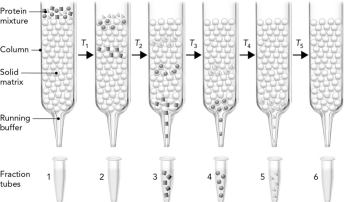
A) squares
B) circles
C) triangles
D) Not enough information is included to determine the protein.

A) squares
B) circles
C) triangles
D) Not enough information is included to determine the protein.

Unlock Deck
Unlock for access to all 100 flashcards in this deck.
Unlock Deck
k this deck
10
The figure below shows how differential centrifugation can be used to isolate four subcellular fractions. Which fraction corresponds to the cytosol fraction? 
A) A
B) B
C) C
D) D

A) A
B) B
C) C
D) D

Unlock Deck
Unlock for access to all 100 flashcards in this deck.
Unlock Deck
k this deck
11
Which separation technique exploits the solubility differences of proteins?
A) centrifugation
B) salting out
C) dialysis
D) ion-exchange chromatography
A) centrifugation
B) salting out
C) dialysis
D) ion-exchange chromatography

Unlock Deck
Unlock for access to all 100 flashcards in this deck.
Unlock Deck
k this deck
12
After centrifugation, the purity of the protein is determined by
A) absorbance measurements.
B) activity units.
C) total protein content.
D) specific activity.
A) absorbance measurements.
B) activity units.
C) total protein content.
D) specific activity.

Unlock Deck
Unlock for access to all 100 flashcards in this deck.
Unlock Deck
k this deck
13
Calculate the specific activity when 500 mg of protein has an activity of 18,000 units.
A) 0.28 units/mg protein
B) 36 units/mg protein
C) 9000 units/mg protein
D) 13,000 units/mg protein
A) 0.28 units/mg protein
B) 36 units/mg protein
C) 9000 units/mg protein
D) 13,000 units/mg protein

Unlock Deck
Unlock for access to all 100 flashcards in this deck.
Unlock Deck
k this deck
14
Which percentage of polyacrylamide would give the best separation for small proteins?
A) 5%
B) 7.5%
C) 10%
D) 20%
A) 5%
B) 7.5%
C) 10%
D) 20%

Unlock Deck
Unlock for access to all 100 flashcards in this deck.
Unlock Deck
k this deck
15
The figure below shows how differential centrifugation can be used to isolate four subcellular fractions. Which fraction corresponds to the membrane fraction? 
A) A
B) B
C) C
D) D

A) A
B) B
C) C
D) D

Unlock Deck
Unlock for access to all 100 flashcards in this deck.
Unlock Deck
k this deck
16
Which type of chromatography separates proteins using specific binding properties?
A) affinity chromatography
B) gel filtration chromatography
C) size exclusion chromatography
D) high-performance liquid chromatography
A) affinity chromatography
B) gel filtration chromatography
C) size exclusion chromatography
D) high-performance liquid chromatography

Unlock Deck
Unlock for access to all 100 flashcards in this deck.
Unlock Deck
k this deck
17
Which of the following peptides would be eluted last when separated using gel filtration chromatography? 
A) A
B) B
C) C
D) D

A) A
B) B
C) C
D) D

Unlock Deck
Unlock for access to all 100 flashcards in this deck.
Unlock Deck
k this deck
18
The figure below shows how differential centrifugation can be used to isolate four subcellular fractions. Which fraction corresponds to the mitochondrial fraction? 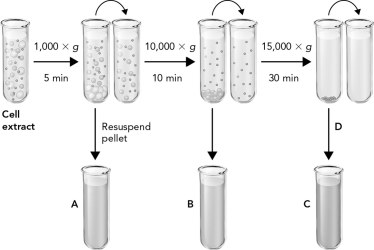
A) A
B) B
C) C
D) D

A) A
B) B
C) C
D) D

Unlock Deck
Unlock for access to all 100 flashcards in this deck.
Unlock Deck
k this deck
19
Biochemical assays are important in the process of isolating proteins because they
A) uniquely identify one protein.
B) separate proteins based on polarity.
C) isolate proteins based on size.
D) determine the molecular weight of proteins.
A) uniquely identify one protein.
B) separate proteins based on polarity.
C) isolate proteins based on size.
D) determine the molecular weight of proteins.

Unlock Deck
Unlock for access to all 100 flashcards in this deck.
Unlock Deck
k this deck
20
After using the salting out method to isolate proteins, how is ammonium sulfate removed from the solution?
A) sonication
B) French press
C) dialysis
D) centrifugation
A) sonication
B) French press
C) dialysis
D) centrifugation

Unlock Deck
Unlock for access to all 100 flashcards in this deck.
Unlock Deck
k this deck
21
Two-dimensional polyacrylamide gel electrophoresis separates proteins based on
A) pI and shape.
B) ligand affinity and molecular weight.
C) shape and ligand affinity.
D) pI and molecular weight.
A) pI and shape.
B) ligand affinity and molecular weight.
C) shape and ligand affinity.
D) pI and molecular weight.

Unlock Deck
Unlock for access to all 100 flashcards in this deck.
Unlock Deck
k this deck
22
In tandem mass spectrometry, the second mass spectrometer
A) determines the nuclear spin of the atoms.
B) determines the mass of peptide subfragments.
C) uses bioinformatics to compare the masses of the peptides.
D) uses electrospray ionization to select peptide fragments.
A) determines the nuclear spin of the atoms.
B) determines the mass of peptide subfragments.
C) uses bioinformatics to compare the masses of the peptides.
D) uses electrospray ionization to select peptide fragments.

Unlock Deck
Unlock for access to all 100 flashcards in this deck.
Unlock Deck
k this deck
23
In tandem mass spectrometry, the first mass spectrometer
A) determines the nuclear spin of the atoms.
B) determines the mass of peptide subfragments.
C) uses bioinformatics to compare the masses of the peptides.
D) uses electrospray ionization to select peptide fragments.
A) determines the nuclear spin of the atoms.
B) determines the mass of peptide subfragments.
C) uses bioinformatics to compare the masses of the peptides.
D) uses electrospray ionization to select peptide fragments.

Unlock Deck
Unlock for access to all 100 flashcards in this deck.
Unlock Deck
k this deck
24
Predict the fragments of the following peptide after cleavage by the V-8 protease. CMVAADGKLEPVS
A) CMVAAD GKLEPVS
B) CMVAADGKLE PVS
C) CMVAADG KLEPVS
D) CMVAAD GKLE PVS
A) CMVAAD GKLEPVS
B) CMVAADGKLE PVS
C) CMVAADG KLEPVS
D) CMVAAD GKLE PVS

Unlock Deck
Unlock for access to all 100 flashcards in this deck.
Unlock Deck
k this deck
25
During solid-phase peptide synthesis, 9-fluorenylmethoxycarbonyl is used
A) as a blocking agent.
B) as an activating agent.
C) to cleave the peptide from the resin.
D) to couple amino acids during the synthesis.
A) as a blocking agent.
B) as an activating agent.
C) to cleave the peptide from the resin.
D) to couple amino acids during the synthesis.

Unlock Deck
Unlock for access to all 100 flashcards in this deck.
Unlock Deck
k this deck
26
Which enzyme or reagent cleaves a peptide at the carboxyl side of a methionine residue?
A) trypsin
B) chymotrypsin
C) V-8 protease
D) cyanogen bromide
A) trypsin
B) chymotrypsin
C) V-8 protease
D) cyanogen bromide

Unlock Deck
Unlock for access to all 100 flashcards in this deck.
Unlock Deck
k this deck
27
The advantage of using an SDS-PAGE gel compared with a native PAGE gel is that the SDS-PAGE gel
A) separates proteins only based on molar mass.
B) gives information about the charge or conformation of the protein.
C) results in a better separation of small proteins.
D) increases the resolution of large and small proteins.
A) separates proteins only based on molar mass.
B) gives information about the charge or conformation of the protein.
C) results in a better separation of small proteins.
D) increases the resolution of large and small proteins.

Unlock Deck
Unlock for access to all 100 flashcards in this deck.
Unlock Deck
k this deck
28
The step in solid-phase peptide synthesis that occurs at number 2 is 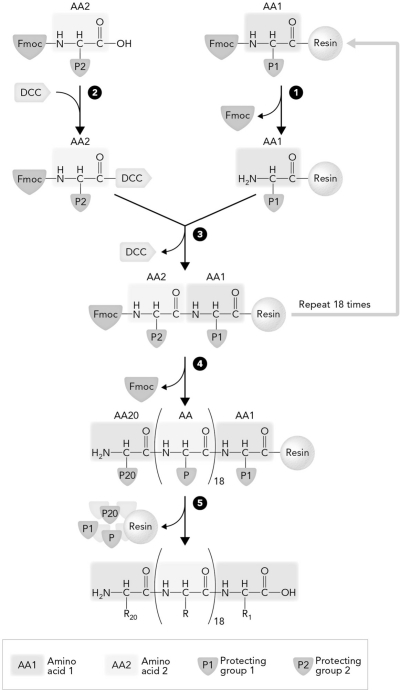
A) deblocking of the residue attached to the resin.
B) coupling of the amino acid.
C) cleavage from the resin.
D) activation of the Fmoc blocked residue.

A) deblocking of the residue attached to the resin.
B) coupling of the amino acid.
C) cleavage from the resin.
D) activation of the Fmoc blocked residue.

Unlock Deck
Unlock for access to all 100 flashcards in this deck.
Unlock Deck
k this deck
29
Which method uses mass to charge ratios as well as a bioinformatics approach to determine the amino acid composition of a protein?
A) X-ray crystallography
B) nuclear magnetic resonance
C) tandem mass spectrometry
D) size exclusion chromatography
A) X-ray crystallography
B) nuclear magnetic resonance
C) tandem mass spectrometry
D) size exclusion chromatography

Unlock Deck
Unlock for access to all 100 flashcards in this deck.
Unlock Deck
k this deck
30
In solid-phase peptide synthesis, which reagent is used to remove the peptide from the solid resin support?
A) HF
B) DCC
C) Fmoc
D) PITC
A) HF
B) DCC
C) Fmoc
D) PITC

Unlock Deck
Unlock for access to all 100 flashcards in this deck.
Unlock Deck
k this deck
31
The step in solid-phase peptide synthesis that occurs at number 3 is 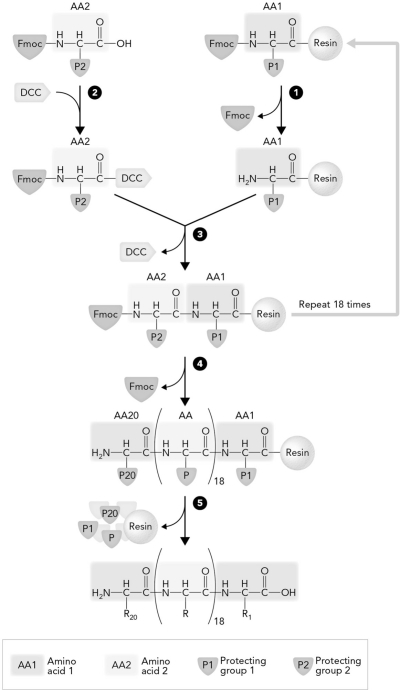
A) deblocking of the residue attached to the resin.
B) coupling of the amino acid.
C) cleavage from the resin.
D) activation of the Fmoc blocked residue.

A) deblocking of the residue attached to the resin.
B) coupling of the amino acid.
C) cleavage from the resin.
D) activation of the Fmoc blocked residue.

Unlock Deck
Unlock for access to all 100 flashcards in this deck.
Unlock Deck
k this deck
32
In isoelectric focusing, a protein with a pH below the pI would
A) migrate toward the anode.
B) migrate toward the cathode.
C) stop migrating.
D) migrate, but there is no way to determine the direction.
A) migrate toward the anode.
B) migrate toward the cathode.
C) stop migrating.
D) migrate, but there is no way to determine the direction.

Unlock Deck
Unlock for access to all 100 flashcards in this deck.
Unlock Deck
k this deck
33
A polypeptide was digested by trypsin and chymotrypsin. Use the following information to determine the polypeptide sequence. 
A) ECFGMREDWKYLM
B) LMYKWMGFCEDER
C) LMYKWDERMGFCE
D) CELMYKWDERMGF

A) ECFGMREDWKYLM
B) LMYKWMGFCEDER
C) LMYKWDERMGFCE
D) CELMYKWDERMGF

Unlock Deck
Unlock for access to all 100 flashcards in this deck.
Unlock Deck
k this deck
34
In isoelectric focusing,
A) negatively charged proteins migrate toward the cathode.
B) negatively charged proteins migrate toward the anode.
C) small proteins migrate the fastest.
D) large proteins migrate the fastest.
A) negatively charged proteins migrate toward the cathode.
B) negatively charged proteins migrate toward the anode.
C) small proteins migrate the fastest.
D) large proteins migrate the fastest.

Unlock Deck
Unlock for access to all 100 flashcards in this deck.
Unlock Deck
k this deck
35
In isoelectric focusing,
A) positively charged proteins migrate toward the cathode.
B) positively charged proteins migrate toward the anode.
C) small proteins migrate the fastest.
D) large proteins migrate the fastest.
A) positively charged proteins migrate toward the cathode.
B) positively charged proteins migrate toward the anode.
C) small proteins migrate the fastest.
D) large proteins migrate the fastest.

Unlock Deck
Unlock for access to all 100 flashcards in this deck.
Unlock Deck
k this deck
36
The advantage of using a native PAGE gel compared with an SDS-PAGE gel is that the native PAGE gel
A) separates proteins only based on molar mass.
B) gives information on the charge or conformation of the protein.
C) results in a better separation of small proteins.
D) increases the resolution of large and small proteins.
A) separates proteins only based on molar mass.
B) gives information on the charge or conformation of the protein.
C) results in a better separation of small proteins.
D) increases the resolution of large and small proteins.

Unlock Deck
Unlock for access to all 100 flashcards in this deck.
Unlock Deck
k this deck
37
Which technique ionizes polypeptides by embedding the tryptic fragments into a light-absorbing matrix and exposing it to a laser?
A) ESI
B) MALDI
C) NMR
D) X-ray crystallography
A) ESI
B) MALDI
C) NMR
D) X-ray crystallography

Unlock Deck
Unlock for access to all 100 flashcards in this deck.
Unlock Deck
k this deck
38
Predict the fragments of the following peptide after cleavage by trypsin. GLMKTYPDSTA
A) GLM KTYPDSTA
B) GLMK TYPDSTA
C) GLMKTY PDSTA
D) GLMKTYPD STA
A) GLM KTYPDSTA
B) GLMK TYPDSTA
C) GLMKTY PDSTA
D) GLMKTYPD STA

Unlock Deck
Unlock for access to all 100 flashcards in this deck.
Unlock Deck
k this deck
39
Which technique ionizes polypeptides by releasing them from a small metallic capillary at high voltage?
A) ESI
B) MALDI
C) NMR
D) X-ray crystallography
A) ESI
B) MALDI
C) NMR
D) X-ray crystallography

Unlock Deck
Unlock for access to all 100 flashcards in this deck.
Unlock Deck
k this deck
40
Below are the steps of solid-phase peptide synthesis: 1. The protecting groups of the amino acids are removed.
2) The peptide is released from the solid support resin.
3) An incoming amino acid is activated at the carboxyl group by DCC and added to the column.
4) Fmoc is removed by treatment with a base and the C-terminal amino acid is attached to the resin molecule.
"5) The resin bound C-terminal amino acid and the incoming N-terminal amino acid are coupled.
What is the appropriate order of these steps?"
A) 3, 5, 4, 2, 1
B) 1, 4, 2, 5, 3
C) 4, 3, 5, 1, 2
D) 2, 4, 5, 3, 1
2) The peptide is released from the solid support resin.
3) An incoming amino acid is activated at the carboxyl group by DCC and added to the column.
4) Fmoc is removed by treatment with a base and the C-terminal amino acid is attached to the resin molecule.
"5) The resin bound C-terminal amino acid and the incoming N-terminal amino acid are coupled.
What is the appropriate order of these steps?"
A) 3, 5, 4, 2, 1
B) 1, 4, 2, 5, 3
C) 4, 3, 5, 1, 2
D) 2, 4, 5, 3, 1

Unlock Deck
Unlock for access to all 100 flashcards in this deck.
Unlock Deck
k this deck
41
Protein NMR is more useful than X-ray crystallography for studying
A) secondary structure elements.
B) large proteins.
C) protein unfolding.
D) static protein structures.
A) secondary structure elements.
B) large proteins.
C) protein unfolding.
D) static protein structures.

Unlock Deck
Unlock for access to all 100 flashcards in this deck.
Unlock Deck
k this deck
42
What is the advantage of using monoclonal antibodies compared with polyclonal antibodies?
A) They are less labor intensive to generate.
B) They can recognize more than one epitope.
C) The process used to produce the antibodies provides unlimited supplies.
D) They can be generated without using animals.
A) They are less labor intensive to generate.
B) They can recognize more than one epitope.
C) The process used to produce the antibodies provides unlimited supplies.
D) They can be generated without using animals.

Unlock Deck
Unlock for access to all 100 flashcards in this deck.
Unlock Deck
k this deck
43
The size of proteins studied by NMR is limited because
A) a small sample size is needed.
B) it is hard to determine the phases of diffracted X-rays.
C) the measurements of the distances between atoms are only approximate.
D) large molecules reorient slowly in solution.
A) a small sample size is needed.
B) it is hard to determine the phases of diffracted X-rays.
C) the measurements of the distances between atoms are only approximate.
D) large molecules reorient slowly in solution.

Unlock Deck
Unlock for access to all 100 flashcards in this deck.
Unlock Deck
k this deck
44
Using the figure below describing monoclonal antibody generation, identify the step where the B cells are fused with the tumor cells. 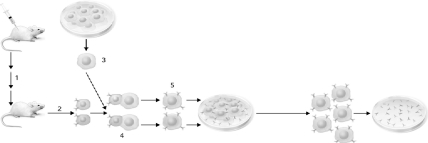
A) 1
B) 2
C) 3
D) 4

A) 1
B) 2
C) 3
D) 4

Unlock Deck
Unlock for access to all 100 flashcards in this deck.
Unlock Deck
k this deck
45
Epitopes on protein antigens are generally located
A) in the heavy chain domains.
B) on polar surface groups in loop regions.
C) in the light chain domains.
D) in association with variable domain amino acid residues.
A) in the heavy chain domains.
B) on polar surface groups in loop regions.
C) in the light chain domains.
D) in association with variable domain amino acid residues.

Unlock Deck
Unlock for access to all 100 flashcards in this deck.
Unlock Deck
k this deck
46
Monoclonal antibodies
A) recognize a single epitope.
B) recognize multiple epitopes.
C) are isolated from leukocytes.
D) are isolated from red blood cells.
A) recognize a single epitope.
B) recognize multiple epitopes.
C) are isolated from leukocytes.
D) are isolated from red blood cells.

Unlock Deck
Unlock for access to all 100 flashcards in this deck.
Unlock Deck
k this deck
47
During the production of polyclonal antibodies, where are the antibodies isolated from?
A) an immortalized tumor cell line
B) liver cells
C) spleen cells
D) blood cells
A) an immortalized tumor cell line
B) liver cells
C) spleen cells
D) blood cells

Unlock Deck
Unlock for access to all 100 flashcards in this deck.
Unlock Deck
k this deck
48
What cells are shown at step number 5 in the figure below? 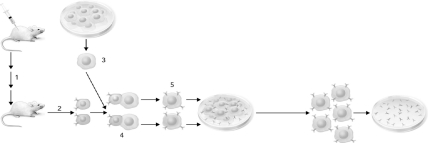
A) B cells
B) immortalized tumor cell
C) hybridoma cells
D) red blood cells

A) B cells
B) immortalized tumor cell
C) hybridoma cells
D) red blood cells

Unlock Deck
Unlock for access to all 100 flashcards in this deck.
Unlock Deck
k this deck
49
The Fab immunoglobin fragment
A) is generally found within -barrels.
B) is located in polar surface groups in loop regions.
C) contains the high-affinity antigen binding site.
D) is responsible for the solubility of the antibody.
A) is generally found within -barrels.
B) is located in polar surface groups in loop regions.
C) contains the high-affinity antigen binding site.
D) is responsible for the solubility of the antibody.

Unlock Deck
Unlock for access to all 100 flashcards in this deck.
Unlock Deck
k this deck
50
During the production of polyclonal antibodies, how are the antigen-specific antibodies purified?
A) dialysis
B) gel electrophoresis
C) size exclusion chromatography
D) affinity chromatography
A) dialysis
B) gel electrophoresis
C) size exclusion chromatography
D) affinity chromatography

Unlock Deck
Unlock for access to all 100 flashcards in this deck.
Unlock Deck
k this deck
51
When cells isolated from the spleen are fused with long-living cells, they produce
A) B cells.
B) immortalized tumor cells.
C) hybridoma cells.
D) red blood cells.
A) B cells.
B) immortalized tumor cells.
C) hybridoma cells.
D) red blood cells.

Unlock Deck
Unlock for access to all 100 flashcards in this deck.
Unlock Deck
k this deck
52
The specific sites on the antigen that interacts with the antibody are called
A) epitopes.
B) immunoglobin light chains.
C) immunoglobin heavy chains.
D) variable-domain amino acid residues.
A) epitopes.
B) immunoglobin light chains.
C) immunoglobin heavy chains.
D) variable-domain amino acid residues.

Unlock Deck
Unlock for access to all 100 flashcards in this deck.
Unlock Deck
k this deck
53
Why is the supply of polyclonal antibodies limited?
A) They are time consuming to produce.
B) The yield is very low.
C) The animals the antibodies are isolated from eventually die.
D) The production is limited by the government.
A) They are time consuming to produce.
B) The yield is very low.
C) The animals the antibodies are isolated from eventually die.
D) The production is limited by the government.

Unlock Deck
Unlock for access to all 100 flashcards in this deck.
Unlock Deck
k this deck
54
What cells are shown at step number 2 in the figure below? 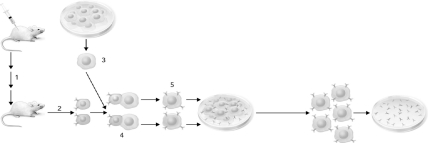
A) B cells
B) immortalized tumor cells
C) hybridoma cells
D) red blood cells

A) B cells
B) immortalized tumor cells
C) hybridoma cells
D) red blood cells

Unlock Deck
Unlock for access to all 100 flashcards in this deck.
Unlock Deck
k this deck
55
The majority of serum proteins and nonspecific antibodies are removed during the generation of polyclonal antibodies by
A) washing with a low pH buffer.
B) gel electrophoresis.
C) size exclusion chromatography.
D) salting out.
A) washing with a low pH buffer.
B) gel electrophoresis.
C) size exclusion chromatography.
D) salting out.

Unlock Deck
Unlock for access to all 100 flashcards in this deck.
Unlock Deck
k this deck
56
During solid-phase peptide synthesis, dicyclohexylcarbodiimide is used
A) as a blocking agent.
B) as an activating agent.
C) to cleave the peptide from the resin.
D) to couple amino acids during the synthesis.
A) as a blocking agent.
B) as an activating agent.
C) to cleave the peptide from the resin.
D) to couple amino acids during the synthesis.

Unlock Deck
Unlock for access to all 100 flashcards in this deck.
Unlock Deck
k this deck
57
What is the advantage of using polyclonal antibodies compared with monoclonal antibodies?
A) They are less labor intensive to generate.
B) They provide the ability to monitor quality continually.
C) The process used to produce the antibodies provides unlimited supplies.
D) They can be generated without using animals.
A) They are less labor intensive to generate.
B) They provide the ability to monitor quality continually.
C) The process used to produce the antibodies provides unlimited supplies.
D) They can be generated without using animals.

Unlock Deck
Unlock for access to all 100 flashcards in this deck.
Unlock Deck
k this deck
58
One of the most difficult steps in X-ray crystallography is
A) using the correct radio frequency pulses to perturb the nuclear spin.
B) determining the phases of diffracted X-rays.
C) dissolving the protein in the appropriate solvent.
D) obtaining a large enough sample for analysis.
A) using the correct radio frequency pulses to perturb the nuclear spin.
B) determining the phases of diffracted X-rays.
C) dissolving the protein in the appropriate solvent.
D) obtaining a large enough sample for analysis.

Unlock Deck
Unlock for access to all 100 flashcards in this deck.
Unlock Deck
k this deck
59
Polyclonal antibodies are
A) derived from B cells isolated from the spleen.
B) isolated from hybridoma cells.
C) a heterogeneous mixture.
D) a homogenous mixture.
A) derived from B cells isolated from the spleen.
B) isolated from hybridoma cells.
C) a heterogeneous mixture.
D) a homogenous mixture.

Unlock Deck
Unlock for access to all 100 flashcards in this deck.
Unlock Deck
k this deck
60
The specific sites on the antibody that interacts with the antigen are
A) epitopes.
B) immunoglobin light chains.
C) immunoglobin heavy chains.
D) variable-domain amino acid residues.
A) epitopes.
B) immunoglobin light chains.
C) immunoglobin heavy chains.
D) variable-domain amino acid residues.

Unlock Deck
Unlock for access to all 100 flashcards in this deck.
Unlock Deck
k this deck
61
The part of the Western blot that contains the protein-specific recognition and facilitates the antigen-antibody interactions is the
A) SDS-PAGE gel.
B) primary antibody.
C) tertiary antibody.
D) filter membrane.
A) SDS-PAGE gel.
B) primary antibody.
C) tertiary antibody.
D) filter membrane.

Unlock Deck
Unlock for access to all 100 flashcards in this deck.
Unlock Deck
k this deck
62
Which animal is most often used to generate monoclonal antibodies?
A) rabbit
B) chicken
C) goat
D) mouse
A) rabbit
B) chicken
C) goat
D) mouse

Unlock Deck
Unlock for access to all 100 flashcards in this deck.
Unlock Deck
k this deck
63
Co-immunoprecipitation proteins are separated through
A) affinity chromatography.
B) SDS-PAGE.
C) HPLC.
D) size exclusion chromatography.
A) affinity chromatography.
B) SDS-PAGE.
C) HPLC.
D) size exclusion chromatography.

Unlock Deck
Unlock for access to all 100 flashcards in this deck.
Unlock Deck
k this deck
64
Below are the steps of a Western blot. What is the correct order? 1. The membrane is incubated with the secondary antibody.
2) The membrane is incubated with the primary antibody.
3) The membrane is washed with a blocking solution.
4) Proteins are transferred to a nitrocellulose membrane.
5) Protein extracts are separated by gel electrophoresis.
A) 5, 4, 3, 2, 1
B) 4, 5, 2, 3, 1
C) 3, 4, 5, 1, 2
D) 2, 5, 4, 3, 1
2) The membrane is incubated with the primary antibody.
3) The membrane is washed with a blocking solution.
4) Proteins are transferred to a nitrocellulose membrane.
5) Protein extracts are separated by gel electrophoresis.
A) 5, 4, 3, 2, 1
B) 4, 5, 2, 3, 1
C) 3, 4, 5, 1, 2
D) 2, 5, 4, 3, 1

Unlock Deck
Unlock for access to all 100 flashcards in this deck.
Unlock Deck
k this deck
65
Compare and contrast the three MOST commonly used homogenization techniques to prepare a cell extract.

Unlock Deck
Unlock for access to all 100 flashcards in this deck.
Unlock Deck
k this deck
66
What is the advantage of using sodium dodecyl sulfate (SDS) in gel electrophoresis?

Unlock Deck
Unlock for access to all 100 flashcards in this deck.
Unlock Deck
k this deck
67
In an ELISA, the capture antibody is a antibody.
A) monoclonal primary
B) polyclonal primary
C) monoclonal secondary
D) polyclonal secondary
A) monoclonal primary
B) polyclonal primary
C) monoclonal secondary
D) polyclonal secondary

Unlock Deck
Unlock for access to all 100 flashcards in this deck.
Unlock Deck
k this deck
68
Most secondary antibodies used in Western blots are covalently linked to the enzyme
A) luciferase.
B) horseradish peroxidase.
C) catalase.
D) hydrolase.
A) luciferase.
B) horseradish peroxidase.
C) catalase.
D) hydrolase.

Unlock Deck
Unlock for access to all 100 flashcards in this deck.
Unlock Deck
k this deck
69
Explain how to separate the following proteins using two different types of chromatography. 


Unlock Deck
Unlock for access to all 100 flashcards in this deck.
Unlock Deck
k this deck
70
In an ELISA, the detection antibody is a antibody.
A) monoclonal primary
B) polyclonal tertiary
C) monoclonal secondary
D) polyclonal secondary
A) monoclonal primary
B) polyclonal tertiary
C) monoclonal secondary
D) polyclonal secondary

Unlock Deck
Unlock for access to all 100 flashcards in this deck.
Unlock Deck
k this deck
71
Protein-specific antibodies can be used to detect proteins within cells conserving the cell architecture using
A) immunofluorescence.
B) Western blot.
C) immunoprecipitation.
D) ELISA.
A) immunofluorescence.
B) Western blot.
C) immunoprecipitation.
D) ELISA.

Unlock Deck
Unlock for access to all 100 flashcards in this deck.
Unlock Deck
k this deck
72
Immunoprecipitation uses an antibody-bead combination to
A) detect the antigen.
B) enrich the protein solution.
C) digest the proteins for use in mass spectrometry.
D) separate the proteins using centrifugation.
A) detect the antigen.
B) enrich the protein solution.
C) digest the proteins for use in mass spectrometry.
D) separate the proteins using centrifugation.

Unlock Deck
Unlock for access to all 100 flashcards in this deck.
Unlock Deck
k this deck
73
During a Western blot, the membrane is washed with a blocking solution before being treated with the primary antibody to
A) retain the position of the proteins in the transfer from gel to membrane.
B) facilitate antibody-antigen interactions.
C) decrease nonspecific antibody binding.
D) facilitate a chemical reaction that can be detected.
A) retain the position of the proteins in the transfer from gel to membrane.
B) facilitate antibody-antigen interactions.
C) decrease nonspecific antibody binding.
D) facilitate a chemical reaction that can be detected.

Unlock Deck
Unlock for access to all 100 flashcards in this deck.
Unlock Deck
k this deck
74
Explain the differences among the three types of column chromatography.

Unlock Deck
Unlock for access to all 100 flashcards in this deck.
Unlock Deck
k this deck
75
Which technique can be combined with mass spectrometry to identify protein antigens in large cellular complexes?
A) immunofluorescence
B) Western blot
C) immunoprecipitation
D) ELISA
A) immunofluorescence
B) Western blot
C) immunoprecipitation
D) ELISA

Unlock Deck
Unlock for access to all 100 flashcards in this deck.
Unlock Deck
k this deck
76
Which technique uses highly specific monoclonal antibodies in a high-throughput form to detect small amounts of antigen?
A) immunofluorescence
B) Western blot
C) SDS-PAGE gel
D) ELISA
A) immunofluorescence
B) Western blot
C) SDS-PAGE gel
D) ELISA

Unlock Deck
Unlock for access to all 100 flashcards in this deck.
Unlock Deck
k this deck
77
If a protocol for a Western blot calls for the use of rabbit anti-mouse antibody, what type of antibody would this be considered?
A) monoclonal primary
B) polyclonal primary
C) monoclonal secondary
D) polyclonal secondary
A) monoclonal primary
B) polyclonal primary
C) monoclonal secondary
D) polyclonal secondary

Unlock Deck
Unlock for access to all 100 flashcards in this deck.
Unlock Deck
k this deck
78
In monoclonal antibody generation, the cells that produce the antibody in the animal are located in cells.
A) heart
B) liver
C) spleen
D) red blood
A) heart
B) liver
C) spleen
D) red blood

Unlock Deck
Unlock for access to all 100 flashcards in this deck.
Unlock Deck
k this deck
79
Why is protein purification often referred to as an art and a science?

Unlock Deck
Unlock for access to all 100 flashcards in this deck.
Unlock Deck
k this deck
80
Which component used in a Western blot is covalently linked to an enzyme?
A) SDS-PAGE gel
B) primary antibody
C) secondary antibody
D) filter membrane
A) SDS-PAGE gel
B) primary antibody
C) secondary antibody
D) filter membrane

Unlock Deck
Unlock for access to all 100 flashcards in this deck.
Unlock Deck
k this deck



